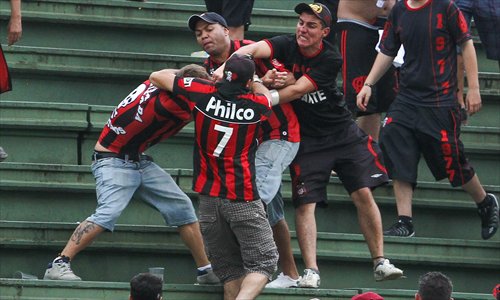HOME >> SPORTS
South American hooligans run amok ahead of World Cup
Source:AFP Published: 2014-1-4 0:13:02

Fans of Atletico Paranaense and Vasco da Gama in clash during the match between the two teams on December 8 in Joinville, Brazil. Photo: CFP
An increase in soccer-related violence in South America is tarnishing the image of the game on the continent just months before Brazil hosts the World Cup.
Thirty people were killed in soccer-related attacks in Brazil alone this year - one less than the record 31 in 2012 - while nine died in neighboring Argentina, leading authorities in that country to ban away fans.
In early December, a fracas broke out between "torcidas organizadas," as hooligans are known in Brazil, following a match between Atletico Paranaense and Vasco da Gama.
The brawl was broadcast live on television, shocking viewers as bloodied victims were beaten and kicked.
Weeks later in Argentina, two members of the "barras bravas" - or hooligans - of local team Newell's Old Boys were shot dead by a fan from bitter rivals Rosario Central.
Other fatalities were recorded in Colombia, Paraguay and Peru, with soccer-related injuries and arrests in Uruguay, Ecuador and Chile.
In some countries in the region, hooligans engage in criminal activities and have designated attack groups. In Argentina, the "barras bravas" are even seen as a constituency and protected by politicians.
Violence reflects problems
For Uruguayan sociologist Leonardo Mendiondo, soccer serves as a window into South America's pent up social frustrations. Much of the region has seen fast economic growth in the past years - along with a widening chasm between the haves and the have-nots.
Mendiondo, like his Ecuadoran counterpart Fernando Carrion, said the fans are a product of the violence-marked societies they live in.
Argentina expert Luis Sustas, meanwhile, said hooligans "are not irrational beings or monsters."
Rather, they see membership of a hardcore fan grouping as defining their place in society, creating a sense of belonging, he said.
The "barras bravas" and "torcidas" often recruit their most die-hard members among the young and unemployed and plan attacks that can sometimes pull in peaceful fans on a wave of enthusiasm, according to observers.
"They let off steam created by social pressures through football," said sociologist Andres Parra from the Central University of Chile. The groups serve as "tribes" to which fans pledge their loyalty, he added.
Club managers shoulder most of the blame, he said.
"Those in charge of the clubs have been playing with fire in offering tickets and power to the barras bravas."
Tourists could be at risk
Brazilian sociologist Maurici Murad warned that foreign fans could be at risk during the World Cup that kicks off on June 12 - if authorities don't take action.
Murad watched the violence between Atletico Paranaense and Vasco da Gama unfurl
on television - four people were injured - and decried the lack of a tough response.
"I felt my house had been invaded by barbarism," he said.
As the author of a book about soccer violence, Murad expressed concern about a repeat once fans from around the world descend on Brazil for the month-long championship.
"Tourists could be at risk," he warned, although President Dilma Rousseff insists the government will crack down hard on trouble makers.
Although the focus is on Brazil in the run-up to the World Cup, it is the Argentine capital that is widely regarded as the main focal point of South American soccer violence.
There, hooligans have gained influence at the heart of the game.
The "barras bravas" from Buenos Aires outfits Boca Juniors and River Plate have become small businesses in their own right, generating revenue through, for example, ticket and club merchandise sales.
An investigation by Argentinian broadcaster C5N found that River Plate's "barra bravas" rake in more than $1 million a year at the club's Monumental stadium.
Argentina has tried to crack down by jailing some ringleaders for orchestrating violence at stadiums, as well as for extortion and drug trafficking.
But that hasn't stemmed their influence both at home and abroad.
Paraguayan sociologist Alberto Candia noted that "Boca Juniors fans exert great influence and pressure" on Paraguayan side Olimpia, which has begun adopting similar methods.
"Management paid for away trips. Financial incentives, free tickets and trips helped the [Olimpia] 'barras' to grow quickly in number, generally under the control of unemployed people on society's fringes," Candia said.
Ecuador Football Federation official Jose Vinueza told AFP the Argentine hooligans also exert influence on his country.
"We have evidence many Ecuadoran 'barras' are especially linked to the Argentines," Vinueza said.
Posted in: Feature, Soccer